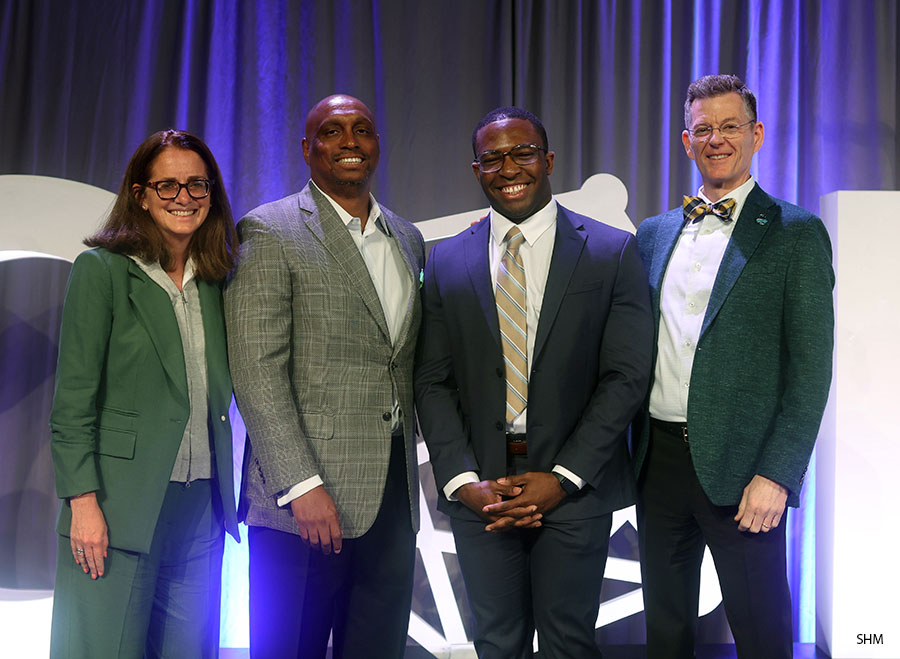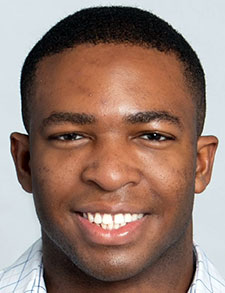SHM’s Hospital Medicine DEI Scholarship Winner: Nnamdi Igwe

Left to Right: Dr. Kris Rehm, Dr. Greg Johnson, Nnamdi Igwe, and Dr. Eric Howell
SHM presented two $25,000 Hospital Medicine Diversity, Equity, and Inclusion Scholarships in April at Converge. Nnamdi Igwe was the recipient of the second scholarship. We spoke with him about his dedication to diversity, equity, and inclusion (DEI).

Igwe
Nnamdi Igwe was born and raised in Nigeria; he moved to the U.S. in 2013. He earned his bachelor’s degree in human development from Cornell University in Ithaca, N.Y., and he’s currently a third-year medical student at Icahn School of Medicine at Mount Sinai in New York.
As a child in Nigeria, Mr. Igwe saw firsthand the consequences of lack of access to high-quality, high-value inpatient care. His personal experiences ignited his desire to pursue a career in hospital medicine. Throughout his medical school journey, he has been engaged in multiple, successful, quality-improvement and patient-safety initiatives that focus on improving the quality of care for hospitalized patients with limited English proficiency.
After completing his medical training, Mr. Igwe aims to pursue a career in academic hospital medicine, practicing in both the U.S. and Nigeria. He aspires to mentor and teach medical students and residents on how to effectively implement system-wide quality improvement and patient safety projects in hospitals.
Mr. Igwe is grateful to his numerous mentors at the Mount Sinai Division of Hospital Medicine—particularly, Dr. Anne Linker, Dr. Vinh-Tung Nguyen, Dr. Xu Tao, Dr. Andrew Dunn, and Dr. Beth Raucher. With the support of his mentors and this scholarship fund, he will continue to explore his interests in hospital medicine, quality improvement, and patient safety, while advocating for marginalized communities. In his free time, he enjoys visiting museums, taking long walks in a park, eating at ethnic restaurants, weightlifting, and meditation.
Q: What’s led to your passion for hospital medicine over other subspecialties?
Growing up in Nigeria, I experienced the effects of inadequate access to high-quality, high-value care. I lost several relatives in hospital settings, and I believe that if they had received better quality inpatient care, they may have been less likely to experience adverse outcomes. These personal losses ignited my interest in improving the care of hospitalized patients, particularly those in vulnerable populations. I hope to create a career in hospital medicine that leverages quality improvement principles to make the hospital a safer place for all patients.
Q: Why is DEI so important to you, especially as it relates to hospital medicine?
DEI is important to me because it promotes the recruitment and retention of a diverse hospitalist workforce that represents the population we serve. I believe diversity in hospital medicine will help promote the delivery of culturally competent care to hospitalized patients.
Q: Medical school is a full-time job on its own. How do you juggle all the outside projects?
Over the years, I have learned good time-management skills. However, what I have found to be most valuable is having a reliable team. My hospitalist mentors have been incredibly supportive, and I know I can always depend on them as we work together to successfully implement various projects. In conclusion, good time management and teamwork make it possible for me to juggle outside projects while in medical school.
Q: What advice would you give people who are just starting medical school?
I cannot emphasize enough the importance of having a mentor who cares about you, your success, your learning, and your overall well-being. As you start medical school, try to connect with attendings, either through shadowing or working on projects with them. Ask to have one-on-one check-ins with them. As time goes on, you will find people you connect with, who can be your mentors long-term.
Mr. Igwe’s scholarship is made possible by its Visionary Sponsor, Sound Physicians. Learn more about SHM’s DEI scholarship.